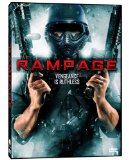Bill Williamson (Brendan Fletcher) is an angry young man. His boss treats him badly, he can’t get good service at the local coffee shop, and his parents are trying, none too subtly or smartly, to get him to move out. He hangs out with a friend who talks a big talk about changing the world, but does nothing. Bill, by contrast, is about to do something: gearing up with so much body armor he becomes a walking tank, he begins a gigantic massacre in town, beginning by blowing up a police station, and going on to gun down anyone who crosses his path. There is, however, rather more method to his madness than might appear.
The indefatigable Uwe Boll here brings us a film that echoes the likes of Falling Down, Targets and Elephant. (And in typically modest fashion, on the commentary track he feels he has improved on Falling Down.) This is one of Boll’s better films, blessed by an excellent lead performance by Fletcher, convincing improvised dialogue (which does produce a couple of grammatical howlers, but hey, so does real-life dialogue), and intense hand-held camerawork. There are some genuinely witty moments, too, such as the scene where Bill enters a bingo hall, and is completely ignored by its denizens. Even at a brisk 85 minutes, however, the film doesn’t have quite enough plot, and thus the rampage itself feels a bit too long. There is also too much reliance on flash-forwards, which ultimately telegraph the resolution too far ahead. As for that resolution, it isn’t without a certain cleverness, but it does tend to muddy the film’s social commentary. But social commentary there is, and there is quite a bit to admire about this effort.
Video
Some of the reds are bit too strong, but otherwise the colors are excellent, as are the contrasts, blacks and flesh tones. There are moments where the film shifts to webcam footage, and the difference is clear and convincing. The overall look of the film is rich without venturing too far outside of a realist aesthetic (the exception being a gigantic explosion early on, but as far as the transfer goes, everything still looks very nice). The aspect ratio is the original 2.35:1 anamorphic widescreen.
Audio
The sound design of the film is, in certain respects, spare. Odd to say about a movie with so much gunfire, but what this means is that, before we get to the rampage, there isn’t that much by way of environmental effects. Which doesn’t mean there isn’t some interesting surround play going on: music cues and snippets of radio chatter slip and snap at the listener from all sides. And when the explosions come, they sound great. The score is very strong, too.
Commentary track: Boll is on hand here, and, as mentioned earlier, he’s pretty pleased with his film, though not without some justification. He is pretty informative, too, about both the making of the film and the ideas behind it.
Special Features
Deleted Scenes: (3:02) A short montage.
Trailers.
Final Thoughts
For better or for worse, Uwe Boll has become such a brand-name director that it is now very difficult to evaluate his work purely on its own terms. In the case at hand, for instance, is this a good Uwe Boll film, or a good film, pure and simple? It is certainly a stellar example of the former. But it is also, on balance, well worth watching.






